From prehistoric to modern art and beyond, the female figure has been a powerful and enduring visual symbol of beauty, desire and idealism. Whether rendered with astounding naturalism or expressive abstraction, the subject of the female body has been central to the development of the greatest artistic movements and talents throughout history. Keep reading to trace the origins and evolutions of meaning of one of the most important icons of all time.
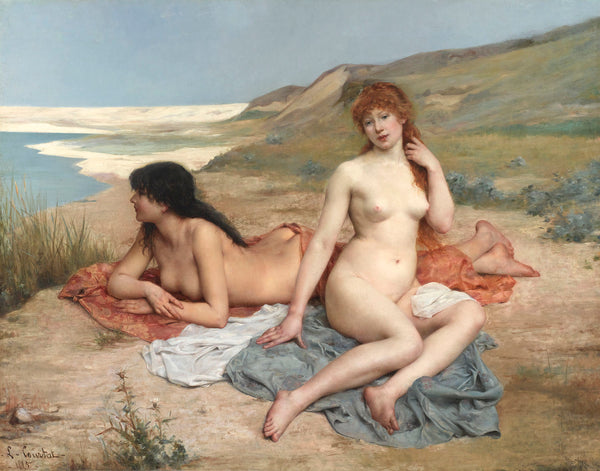
Baigneuses by Louis-Joseph Courtat. Circa 1885. M.S. Rau.
1. Mythological Roots
The portrayal of the female nude in art history has long been intertwined with mythological narratives, serving as a symbol of fertility, sexuality and maternity since prehistoric times. In Greco-Roman mythology, goddesses such as Aphrodite and Venus were depicted in sculptures and paintings as idealized embodiments of feminine beauty and power.
These divine figures were often depicted in the nude, symbolizing their role as creators of life and sources of fertility. Mythical scenes involving goddesses, nymphs and queens—such as Leda and the Swan—told layered stories of desire, sensuality and the cycles of human life.
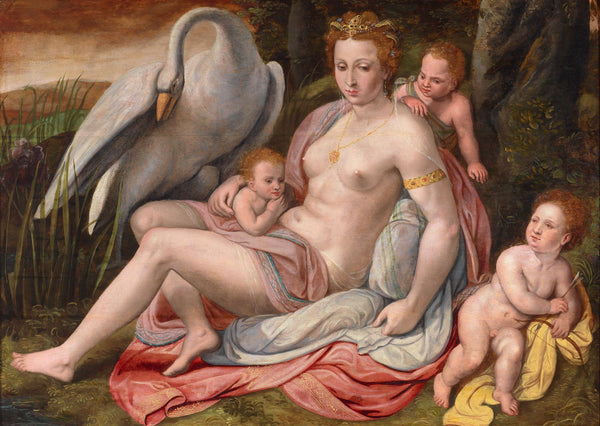
Fun Facts: Have you seen these mythological women?
- Aphrodite/Venus: The goddesses of love, purity and natural beauty in Greek and Roman mythology were often depicted nude.
- The Three Graces: These nymphs were the embodiment of beauty, charm and grace, shown as three embracing women.
- Eve from the Judeo-Christian Tradition: Represents innocence, temptation, and the complexity of human nature after the fall, often depicted in a garden holding an apple.
- Kali in Hindu Mythology: Her nakedness reflects the ultimate reality and the destruction of evil. She is sometimes depicted naked or only wearing a skirt made of human arms and a garland of human heads.
- Inanna/Ishtar: In Mesopotamian mythology, her body symbolizes power, truth, fertility and sexuality. She is often depicted with wings and a traditional crown.
2. History Repeats
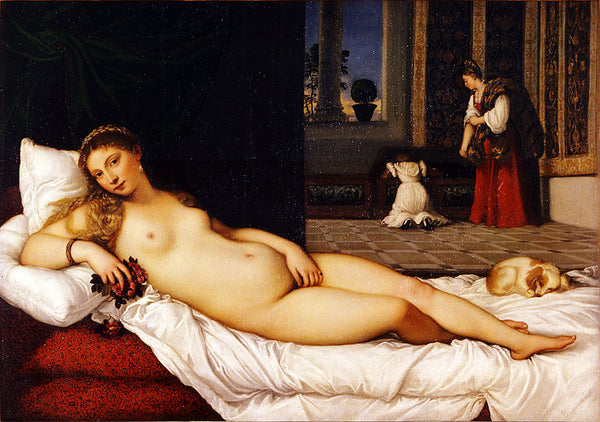
Venus of Urbino by Titian. Circa 1535. Source.
The 15th, 16th and 17th centuries witnessed a resurgence of interest in classical themes and subjects like the female nude, due in part to the rediscovery of sculptures and pottery from antiquity. Masters such as Michelangelo and Titian drew inspiration from ancient Greek and Roman sculptures, using the lush female form as a means of understanding perspective, volume and anatomy to bring an unprecedented level of naturalism to their compositions. Renaissance artists sought to capture the idealized proportions and graceful curves of the naked woman, imbuing their works with an alluring sense of perfect harmony and balance.
This artistic fascination with idealized nudes continued into the 18th and 19th centuries, with artists like Jean-Auguste-Dominique Ingres and Eugene Delacroix ushering in the shift from Neoclassicism to Romanticism with their dramatic canvases. One of the most iconic reclining female nudes is Ingres’ Grande Odalisque of 1814, a sensuous exploration of themes of desire, exoticism and the sublime—all communicated through the female body and her sumptuous setting.
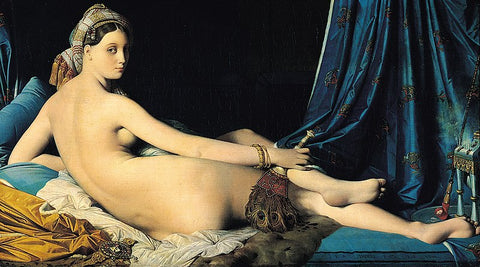
Grande Odalisque by Jean-Auguste-Dominique Ingres. 1814. Source.
Fun Facts: Have you taken a peek behind the curtain?
- Renaissance Anatomical Studies: Artists like Leonardo da Vinci conducted detailed anatomical studies to achieve perfection in their depictions of the nude, often in secret due to the era's restrictions on disturbing corpses.
- The Birth of Venus: Sandro Botticelli's The Birth of Venus was an anomaly in its time, reviving the full-scale depiction of the female nude for the first time since antiquity, signaling a shift in artistic and societal norms.
- Mythological Disguise: Artists often depicted nudes within mythological contexts as a clever guise to explore the human form without offending sensibilities, using the narratives of antiquity to justify the exploration of nudity.
- A Woman’s Perspective: One of the few female artists of the Renaissance era, Artemisia Gentileschi began to explore the female nude, challenging the traditional male gaze and offering an important portrayal from a woman’s perspective.
- Rococo Hidden Messages: François Boucher's delicate nudes often carried hidden messages of sensuality and flirtation, created for the private chambers of the French court rather than public display.
3. Feminine Pastoral & Mother Nature

The Bather by Childe Hassam. Circa 1905. M.S. Rau.
The portrayal of the natural world as feminine, often referred to as "Mother Nature," has deep historical and cultural roots that stretch across civilizations and epochs. In ancient cultures, goddesses such as Gaia in Greek mythology and Terra Mater in Roman mythology were revered as embodiments of the earth and its elements.
In medieval allegorical literature, such as Le Roman de la Rose, nature was personified as a beautiful woman, embodying both the bounty and the unpredictability of the natural world. The Renaissance also saw the rise of the pastoral genre, which idealized rural life and celebrated the tranquility and abundance of the natural landscape.
The concept of Mother Nature as a nurturing and protective figure has persisted into the modern era, shaping our cultural imagination and influencing how we perceive and interact with the natural world. From eco-feminist movements to contemporary art and literature, the female body continues to inspire reverence, awe and a sense of interconnectedness with the earth.
Fun facts: Have you heard of these other connections between women and nature?
- Earth Day: This holiday draws directly from ancient ceremonies honoring female Earth deities, illustrating the evolution of eco-consciousness.
- Weather's Personification: Did you know Hurricanes had only female names until 1978?
- Natural Wonders Named After Goddesses: Phenomena like the Aurora Borealis and volcanic Mount Pelée bear names of mythological goddesses.
- Mother Plant: This botanical term highlights the nurturing aspect of Mother Nature in ensuring plant species' continuation.
4. Morality & Art

Salome by Marie Felix Hippolyte-Lucas. 20th Century. Source.
Artistic and religious movements have often converged throughout history, and the subject of the female form often appeared as a complex symbol in religious works. For Christians—who represented the vast majority of European patrons for centuries—the nude image could evoke feelings of desire, anxiety, guilt or contempt. A reminder of original sin extending back to the biblical tale of Adam and Eve, the unclothed feminine form is a longstanding source of conflict and condemnation.
While the popularity of the nude in religious art has ebbed and flowed with the ages, the female body has always been used to represent certain ideals. Depictions of the Madonna, always modestly clothed in billowing robes, evoke notions of perfect purity and innocence, which can be starkly contrasted with the nude depictions of Old Testament figures such as the temptress Salome. Presented in this context, the female nude is a lesson in morality for a pious viewer, challenging them to confront their own desires and moral convictions.
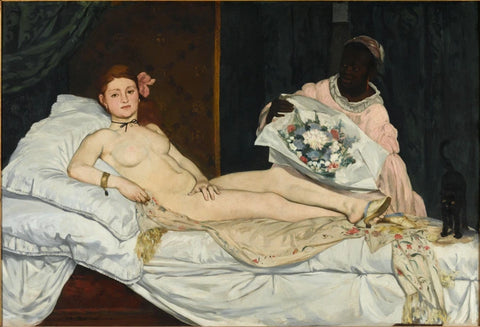
Olympia by Edouard Manet. 1863. Source.
Manet’s nude depiction of recognizable dancer Victorine Meurent—whose confrontational gaze holds the viewer in its thrall—caused a scandal for its unabashed realism and challenge to conventions, marking a pivotal moment in the portrayal of the female nude.
Fun facts: Can you find the moral codes hidden in these artistic choices?
- Renaissance Layers: Artists cleverly layered symbols with their nudes, like fig leaves and strategic shadows, to navigate moral landscapes while celebrating humanism.
- Rococo’s Hidden Language: Rococo art, with its airy erotism, often employed pastoral settings as a coded language for sensuality and flirtation, skirting the era's moral scrutiny.
- Victorian Contradictions: The Victorian era's prudish customs hid a fascination with the nude in art, provided it was cloaked in academic or mythological justification.
- Modernist Breaks: Early 20th-century movements like Cubism fragmented the nude, challenging traditional views on beauty and modesty through abstract forms.
5. Modern Interpretations of the Everyday Nude

Après Le Bain by Pierre-Auguste Renoir. Circa 1898. M.S. Rau.
The modern era bore witness to immense change in cultural attitudes, and artists responded by bringing their depictions of the female nude accordingly up to date. Rendered with a casual naturalism that first shocked, and then delighted, modern audiences, the feminine form began to increasingly appear outside of the confines of historical, mythological or religious contexts.
They were presented instead as real, contemporary women occupying the intimate spaces of their homes, urban scenes, outdoor settings and more. Importantly, as women artists became a more prevalent part of artistic movements, the female body was rendered from the female perspective, rather than through the masculine gaze of their male counterparts.
In embracing more realistic approaches to the female nude, artists of the 20th and 21st centuries have challenged traditional standards of beauty and confronted taboos and social issues. Contemporary artists continue to use the female body to explore themes of femininity, identity and sexuality, celebrating the unique qualities and experiences of women in the modern world.
Fun Facts: Can you spot the female form in modern art?
- Photography's Influence: The advent of photography catalyzed a move towards abstraction when painting the nude, as artists sought to distinguish their work from photographic realism.
- Cubism's Dissection: Cubism fragmented the nude into geometric shapes, reflecting a modernist preoccupation with deconstructing reality and the human form itself.
- Surrealism's Subconscious: Surrealist nudes ventured into dreamlike realms, merging body and landscape to explore the unconscious mind's influence on perceptions of the female form.
- Abstract Expressionism's Raw Energy: Willem de Kooning’s Women blended abstract and figurative elements to depict the nude as a powerful reservoir of emotional and physical force, removed from stereotypical beauty.
When visiting any art museum, we are almost guaranteed an encounter with the female nude. From ancient mythological narratives to groundbreaking depictions of modern women, artists have utilized the female form to convey ideas about beauty, desire, nature, gender, social norms and so much more. With its ubiquitous presence and symbolic power, the female nude is one of art history's cornerstones that is certain to withstand the test of time.
Be sure to check out our Nude Collection and many others!






